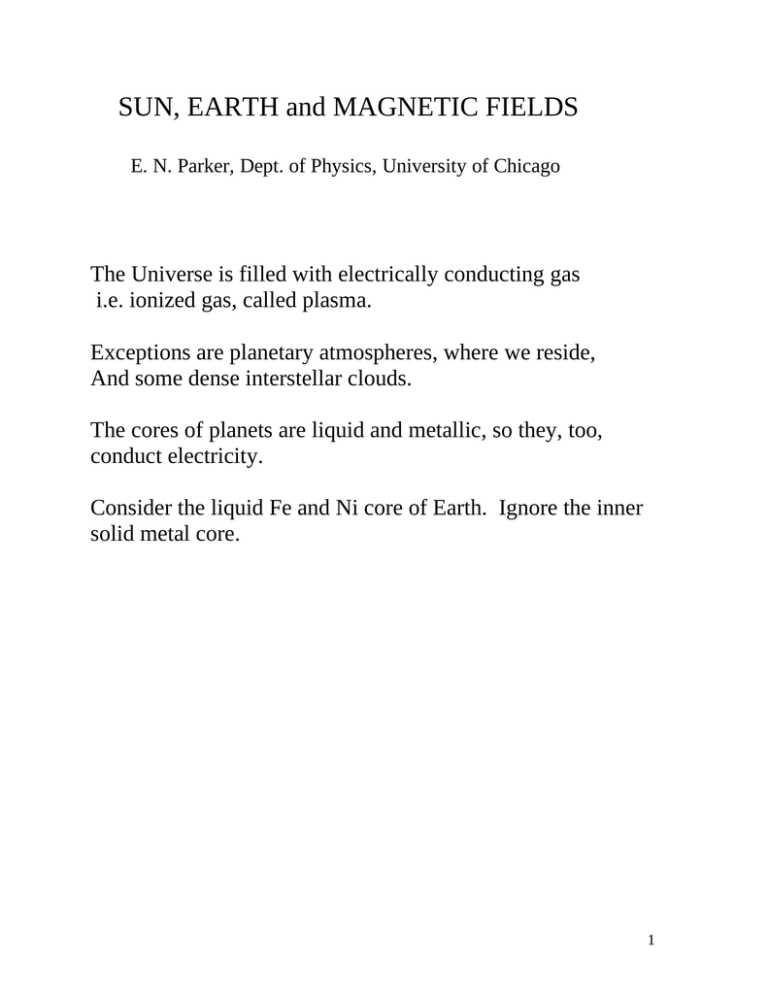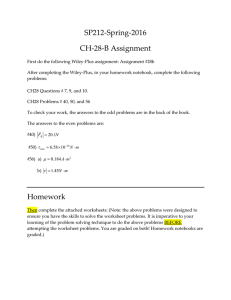SUN, EARTH and MAGNETIC FIELDS
advertisement

SUN, EARTH and MAGNETIC FIELDS E. N. Parker, Dept. of Physics, University of Chicago The Universe is filled with electrically conducting gas i.e. ionized gas, called plasma. Exceptions are planetary atmospheres, where we reside, And some dense interstellar clouds. The cores of planets are liquid and metallic, so they, too, conduct electricity. Consider the liquid Fe and Ni core of Earth. Ignore the inner solid metal core. 1 2 3 If left to itself the magnetic field of Earth would decay with a half-life ~20,000 years, as a consequence of the electrical resistivity of the liquid Fe, Ni core. The magnetic field is mired in the liquid core because the electric currents have to flow so long as the field exists, and the currents can flow only where the material conducts electricity. THE MAGNETIC FIELD IS CAUGHT UP IN THE CONDUCTING CORE! 4 Suppose that somewhere in the first 20,000 years the liquid core is stirred in some simple way over a period of, say, 100 years. The magnetic field is caught up everywhere throughout the liquid iron core, so the field stirs along with the liquid ion. The non-uniform rotation stretches out the north-south field component into an azimuthal configuration, so that the azimuthal field is soon the dominant field component. Start with a south pointing magnetic field in the core. 5 6 7 8 9 10 This combination of non-uniform rotation and cyclonic convection, called an α ω-dynamo, appears to be the basic source of magnetic field in planets, stars, and galaxies. There are many other dynamo processes , but they are generally less efficient than the αω -effect. The magnetic field of the Sun is evidently also generated by the same αω -dynamo effect, yielding an oscillating magnetic field in the spherical shell geometry of the solar convective zone (period ~ 22 years). In summary, we live in a magnetic universe: We may presume that most stars are magnetically active like the Sun, but the Sun is the only star available for direct study. The Galaxy is filled with magnetic field, and even intergalactic space appears have a magnetic field only a modest factor weaker than the magnetic field of the Galaxy, The origin of such an extensive field is not at all clear. 11 Magnetic fields are restless, created by the convection and continually deformed by the convection. So the Sun is never truly quiet even during the cyclic periods of minimum activity. The magnetic fields of the Sun are swirled and contorted by the convection and non-uniform rotation, providing Flares on all scales 2. Prominences 3. Coronal mass ejections 4. Sunspots 5. Corona 6. Solar wind 7. X-ray corona 8. Bright faculae 9. 11 and 22 year magnetic cycle 10. Variations in solar brightness 11. Variations in the cosmic ray intensity 1. 12 13 14 15 16 The Terrestrial Consequences: Climate variation power outage disruption of communication satellites. Solar wind & CME’s impact the magnetic field of Earth producing magnetic fluctuations magnetic substorms magnetic storms and the aurora. Together with UV emission from flares the geomagnetic fluctuations disturb the ionosphere and radio communications. Acknowledgement: The figures shown in this presentation are copied from the Lockheed-Martin calendars for 2004, 2008, 2009. 17



